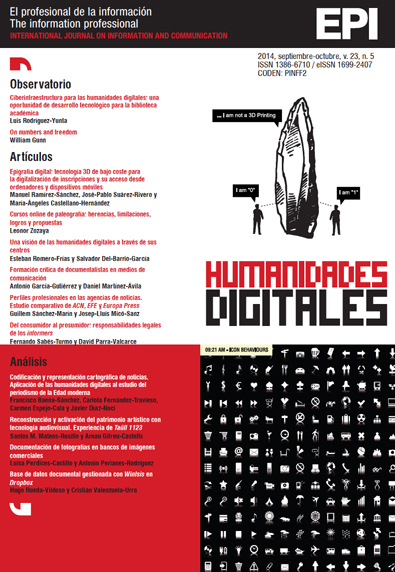Encoding and mapping news. Applying digital humanities methods to research on journalism in the Modern age
DOI:
https://doi.org/10.3145/epi.2014.sep.09Keywords:
Digital humanities, Digital history, Journalism history, Modern age, Newsbook, Newssheets, Newspapers, Periodicals, xml/TEI, Markup, Mapping, Cartographic.Abstract
Digital humanities offer new possibilities to do historical research on journalism in the Modern age. Based on the so-called digital history techniques and methods, we suggest a need to find new, uniform strategies that use the most commonly used standards and protocols in the international scholarly community, so we can construct digitally tagged corpora for future systematic analysis. We review the traditional criteria used to describe newssheets, using the concept of seriality and propose a customized xml/TEI schema to codify this type of texts. We present the preliminary results of the mapping of the news flow networks in the Modern age in Europe. Finally, the conclusions shed some light on the relevance and benefits of applying digital humanities tools to the study of the first European manifestations of what was to become known as "˜journalism´.
Downloads
Downloads
Published
How to Cite
Issue
Section
License
Dissemination conditions of the articles once they are published
Authors can freely disseminate their articles on websites, social networks and repositories
However, the following conditions must be respected:
- Only the editorial version should be made public. Please do not publish preprints, postprints or proofs.
- Along with this copy, a specific mention of the publication in which the text has appeared must be included, also adding a clickable link to the URL: http://www.profesionaldelainformacion.com
- Only the final editorial version should be made public. Please do not publish preprints, postprints or proofs.
- Along with that copy, a specific mention of the publication in which the text has appeared must be included, also adding a clickable link to the URL: http://revista.profesionaldelainformacion.com
Profesional de la información journal offers the articles in open access with a Creative Commons BY license.




